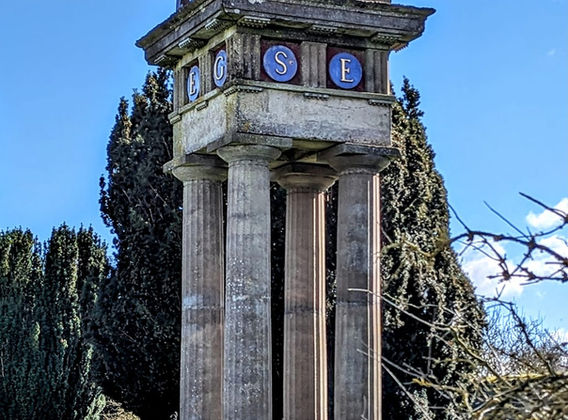Flintham
Staunton-in-the-Vale
Staunton in the Vale – One of the oldest families in the UK, The Crusades and a very, very rude gargoyle
to see this and more of Newarks beautiful surrounding villages - https://www.newarkguide.co.uk/surroundingvillages
If you’ve ever driven through Staunton-in-the-Vale and thought, “Well, that was quick,” you’re not alone. But take the road opposite the pub and you’ll find yourself in a time capsule of English history.
Nestled just a few miles from Newark, Staunton is a walker’s paradise. A 7km route starting and ending at The Staunton Arms (home of a legendary Sunday roast) takes you through scenic villages and centuries of stories (also takes you through Kilvington and Alverton - https://www.newarkguide.co.uk/kilvingtonalverton )
Staunton-in-the-Vale is a village that wears its history like a well-worn tweed jacket—comfortable, distinguished, and with a few surprising stories in its pockets. From the Norman Conquest to the Second World War, this unassuming village has been home to one of England’s oldest families, witnessed the rise and fall of empires, and even played host to a rather cheeky gargoyle.
- The Staunton Family: A Legacy Etched in Stone
The Staunton family has resided in the area since at least 1041, making them one of the few English families still living on their ancestral estate. A tower at Belvoir Castle still bears the family name, and tradition dictates that the head of the Staunton family presents the gold key to the tower when royalty visits.
Sir Walter Scott, no stranger to romantic landscapes, described Staunton-in-the-Vale as “one of those beautiful scenes which are so often found in England.” He visited the Hall in the 1800s while writing *Heart of Midlothian*, basing the fictional Willingham on Staunton Hall.
The Staunton family has never sought titles or headlines. As *Country Life* put it, they represent “a solid, moving and magnificent side of county life.” From medieval manors to modern conservation, they have upheld traditions with quiet dignity for nearly a millennium.
Today, Edmund Staunton continues the legacy, adorning the estate with classical architecture and preserving the landscape. A temple on an island in a small lake offers a serene view of Belvoir Castle, still watched over by the family that once defended it.
- St Mary’s Church: Sanctuary and Scandal
St Mary’s Church, originally the family chapel, now serves as the parish church for Staunton and Flawborough. While parts of the church date back to the 12th century, the tower is a 14th-century relic, and the rest was rebuilt in 1853–54. The church is dedicated to St Mary, The Blessed Virgin, and features a rather rude gargoyle—proof that medieval stonemasons had a sense of humour.
- Staunton Hall: A Fortress of Loyalty
The 16th-century Staunton Hall, a Grade II* listed building, has seen its share of drama. During the English Civil War, William Staunton, a staunch Royalist, raised a troop of 1,200 soldiers at his own expense. While he was away, his wife and twenty servants defended the Hall against Roundhead forces. The skirmish left bullet marks on the north porch door, and Mrs. Staunton herself reportedly fired from a window before retreating to France with her children. The Hall was later extended in the 18th century, blending Tudor stone with Georgian brick.
- The Staunton Arms: Pints and Piety
Built two centuries ago for estate workers, The Staunton Arms originally operated under a six-day license due to the family’s religious convictions. Sold in 1978, it now opens daily and remains a favourite for locals and visitors alike.
- WWII Memorial: The Last Crew of Lancaster W4270
On February 18, 1943, a Lancaster bomber from 61 Squadron crashed near Staunton, killing all seven crew members. The pilot, WOII Thomas Herbert Warne from Saskatchewan, was just 23. Thanks to the efforts of local historian Di Ablewhite and others, a memorial now stands in the new burial ground of Staunton Church, featuring a Lancaster propeller blade and commemorative plaques. The site is part of the Nottinghamshire Historical Aviation Trail and draws hundreds of visitors annually.
- Crusades, Scandals, and Civil Wars
The Stauntons have a colourful history. In 1188, William de Staunton sent a freed villein, Hugh Travers, to fight in the Third Crusade in his place. Hugh survived the journey to Jerusalem and returned a free man, paying rent in cumin and incense.
In 1299, Cecily, Lady Staunton, was convicted of adultery. Her lover, William de Breadon, forced a messenger to eat the summons. Cecily was sentenced to be whipped in Staunton churchyard, Nottingham market, and Bingham market. De Breadon was excommunicated.
During the Civil War, William Staunton fought at Edgehill and helped defend Newark. After the war, he returned to a damaged estate and mounting debts. His descendants juggled finances and marriages to keep the estate afloat, including the formidable “Old Devils”—three unmarried sisters who successfully challenged the Duke of Rutland over water rights.
Whether you come for the roast, the rude gargoyle, or the remarkable stories, you’ll leave with a deeper appreciation for the resilience and richness of rural England.
References
[1] Staunton Surname Meaning & Staunton Family History at ... - Ancestry
[2]
[3] Staunton History, Family Crest & Coats of Arms - HouseofNames
[4] Staunton Genealogy | WikiTree FREE Family Tree















